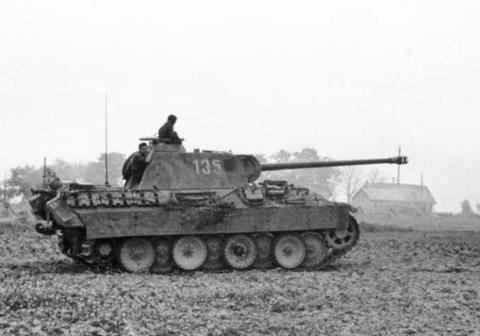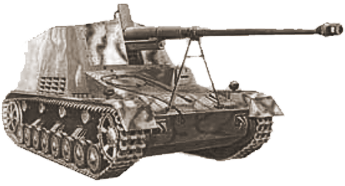One of The Biggest Tank Battles You Have Probably Never Heard About

As we approach the 70th anniversary of the Warsaw Uprising I thought it would be appropriate to set the stage for the brave but doomed efforts of the Polish Resistance to free their city from Nazi occupation. Late in July of 1944 and as the Red Army approached Warsaw's outskirts it must have seemed as if the Soviet war machine was unstoppable. Alas, this would prove not to be true.
Even though much of the blame for the failure of the Polish Resistance to overcome their Nazi overlords must be placed at Stalin's feet (with his decision to not raise a finger to help the courageous resistance effort within Warsaw), there is another reason as well: the enduring strength, recuperative ability, and hitting power of the Wehrmacht.
This is all the more remarkable because by the final two weeks of July 1944 the Wehrmacht, and in particular Army Group's Center and North Ukraine had suffered the greatest defeats delivered against Nazi Germany's military during the Second World War. In particular the Red Army's Operation Bagration had virtually annihilated Army Group Center; with Germany's one time premier Army Group losing 350,000 captured or killed in less than one month. Nevertheless, in spite of such losses the Red Army's victory had come at a price; in the form of hundreds of thousands of casualties, and immense quantities of lost war material.
Consequently, as the Red Army penetrated into Eastern Poland and toward Warsaw its advance not only slowed but ran into a veritable roadblock in the form of hastily assembled German reserves, all of which would lead to one of the great tank showdowns of the war.
For late in July 1944 the Soviet Marshal Konstantin Rokossovsky’s 1st Belorussian Front’s offensive had run into concentrated German counterattacks delivered by five half strength German panzer divisions. In spite of their individual weakness however these panzer divisions, when joined together, proved quite formidable. The panzer divisions; Parachute-Panzer Division Herman Goering, SS-Panzer Divisions Totenkopf and Wiking, and the 4th and 19th Panzer Divisions would end up decimating two of the Soviet 2nd Tank Army’s three tank corps in a span of just over two frenetic weeks of combat east and southeast of Warsaw.[1]
Rokossovsky’s 1st Belorussian Front’s drive west and Ivan Konev’s 1st Ukrainian Front’s drive northwest had ended up bringing each Soviet Front into the path of the German armor grouping. Initially of course and just east of the Bug River the Soviet Front’s had faced less than overwhelming resistance as their movement toward Warsaw inexorably ground on early in the day on July 18, 1944. Initial Nazi resistance, such as it was, primarily existed in the form of the German Second Army, under General der Infanterie Walter Weiss. To Weiss’ immediate south and just east of the Bug River stood the VIII Corps and LVI Panzer Corps of Army Group North Ukraine’s Fourth Panzer Army. Both these German groupings were exceedingly weak; especially in comparison to their primary opponent; Rokossovsky’s immense command.
The 1st Belorussian Front’s northern wing alone comprised five rifle army’s all lined up facing the German Second Army. The 1st Belorussian Front’s southern wing was even stronger and included, running north to south, the 47th Army, 8th Guards Army, 69th Army and 7th Guards Cavalry Corps in line with the 2nd Guards Cavalry Corps, 2nd Tank Army, 11th Tank Corps and 1st Polish Army ready as potent mobile reserves. Rokossovsky’s southern grouping faced the Fourth Panzer Army’s VIII and LVI Corps. In addition the German Fourth Army also had to deal with Konev’s 1st Ukrainian Front’s 3rd Guards Army.[2]The forces assembled just on the 1st Belorussian Front’s left, or southern wing, totaled 416,000 men, 8,355 artillery pieces, mortars and rockets, 1,748 AFV’s, plus the 1,465 combat aircraft in the Soviet 6th Air Army.
The Soviet offensive began on July 18th and met with immediate success. It not only crushed the Fourth Panzer Army’s left flank but Rokossovky and Konev’s Fronts also completed their long awaited link up further stabilizing the Soviet hold on Eastern Poland. These initial successes meant the German Second Army had to stand alone against the brunt of Rokossovsky’s Front.[3]At this point however, Stalin intervened, and ordered Lublin taken so that he could put Moscow’s stamp on Poland’s political future. In accordance with Stalin’s command the Polish Home Army and 2nd Tank Army easily took Lublin. At the same time Konev’s 3rd Guards Army and Rokossovsky’s men finished destroying the Fourth Panzer Army’s left flank. That said, help for the Germans, was arriving. For instance, the reforming German Ninth Army, under General Nikolaus Vormann, formed a weak defensive front but one including the recently arrived Parachute-Panzer Grenadier Division Hermann Goring and its relatively strong complement of 63 AFVs.[4]
As the Ninth Army redoubled its efforts to prepare for the impending clash Stavka ordered Rokossovsky to direct his efforts further west, toward Warsaw’s suburb of Praga, east of the Vistula. This would assist Marshal Georgy Zhukov’s 2nd Belorussian Front as it fought northeast of Warsaw near the Narew River. For his part, Zhukov sought to forge bridgeheads across the Vistula and Narew Rivers, with these rivers bracketing Warsaw from the east and north, as the jumping off points for the next Soviet offensive.[5]
Further south the Soviet 2nd Tank Army mostly comprised the 3rd Tank Corps, 8th Guards Tank Corps and 16th Tank Corps, and spearheaded Rokossovsky’s 1st Belorussian Front as it fought near the Vistula. It was this advance by the 2nd Tank Army which led to the great clash of armor as the aforementioned German panzer divisions met it head on. In particular, the tank on tank combat that occurred between July 18 and 27th ranked as some of the heaviest faced by the 2nd Tank Army during the war. This combat had reduced the 2nd Tank Army from the powerful 810 AFV’s, including 103 Lend-Lease M4A2 Sherman and Mark IV “Valentine” tanks, with which it had begun the offensive to only about 586 AFV’s in running condition by July 27th.[6]
The bulk of the damage inflicted upon the Soviet 2nd Tank Army had come from the German XXXIX Panzer Corps, under Lt. General Dietrich von Saucken. This panzer corps initially contained the 70 AFV strong 19th Panzer Division and the Parachute-Panzer Grenadier Division Hermann Goring attacking eastward. It’s efforts were bolstered by the 3rd SS-Panzer Division Totenkopf and 5th SS-Panzer Division Wiking at they fell back toward the west. In addition the 4th Panzer Division had redeployed from the northeast and put onto the battlefields 78 AFVs in running order. Perhaps as important for the Germans as this mass of panzer divisions was the combined arms support provided in addition to the panzer division’s own integral component of engineers, panzer grenadiers, anti-tank guns, and other such arms. An especially powerful addition to the German defensive effort came from the nearby 6th Luftflotte and its near constant presence in support over the battlefield. In addition the Luftwaffe had also diverted strong anti-aircraft batteries from Warsaw to outside the city bolstering the German infantry fighting south and east of the city and thus freeing up the panzer divisions to fight the Soviet armor.[7]
In spite of the strength of the German defensive effort by July 29th the 8th Guards Tank Corps had closed to within 15 miles of Warsaw’s eastern suburb of Praga. But German panzers and the Luftwaffe relentlessly hammered at Rokossovsky’s spearhead. Meanwhile, Marshal Vasily Chuikov, the hero of Stalingrad, and his elite 8th Guards Army widened his bridgehead across the Vistula south of Warsaw.[8]Nevertheless, on August 1st counterattacks launched by the 19th Panzer Division and Parachute-Panzer Division Hermann-Goring penetrated the 2nd Tank Army’s defensive front. Elements from the 3rd and 5th SS-Panzer Divisions (Totenkopf and Wiking) attacking from the east put further pressure on 2nd Tank Army. This cut off 3rd Tank Corps from the rest of the 2nd Tank Army even as the 8th Guards Tank Corps slammed into the two SS Panzer Divisions from the south. On August 2nd the 4th Panzer Division joined the battle. German attacks on subsequent days finished the decimation of the 2nd Tank Army.[9]
Though there is some debate as to Soviet losses the consensus appears to be that the 2nd Tank Army lost approximately 340 AFVs between July 29th and August 6th and a total of 470 AFVs between July 18th and August 6th. Control over the battlefield allowed Hermann-Goring to report 51 operational tanks on August 6th, only twelve less than one week earlier. Totenkopf and Wiking reported 56 and 45 tanks in running order respectively, representing roughly one-quarter less than their total “runners” from a week earlier.[10] That said losses in the other combat arms had also cost the Germans additional casualties their rapidly dwindling armies could ill afford.[11]
1 Erickson, John, The Road to Berlin, (Westview Press, 1983) at page 246.
2 Bacyk, Norbert, The Tank Battle at Praga July-Sept. 1944 The 4th SS-Panzer-Corps vs the1st Belorussian Front, (Leandoer & Ekholm Publishing, 2009) at page 209.
3 Ibid., 25-27 and 210.
4 Ibid., 31-37.
5 Ibid., 38-42.
6 Ibid., 48.
7 Ibid., 53, 64, 84.
8 Ibid., 62.63.
9 Ibid., 64-77.
10 Ibid., 91-93.
11 Glantz, David M., and House, Jonathan M., When Titans Clashed, How the Red Army Stopped Hitler, (University Press of Kansas, 1995) at page 215
Photo Credit: Bundesarchiv Bild 101I-696-0432-13, Polen, Panzer V "Panther" auf dem Feld.2 (German Panzer Mark V "Panther" in Poland During Summer of 1944)



Post new comment